Abb TPS52-F33 User Manual

Operation Manual
TPS52-F33
|
|
ABB Turbo Systems Ltd |
||||
|
|
CH 5401 Baden |
|
|||
Type |
TPS52-F33 |
HT845348 |
|
|||
nMmax |
843 |
1/s |
t Mmax |
680 |
°C |
|
nBmax |
801 |
t Bmax |
650 |
|||
|
|
|||||
SOLD06 |
00250 kg |
20 |
60 |
60 |
||
Year |
2020 |
|
Application according to |
|||
|
the Operation Manual |
|||||
|
|
made in Switzerland |
|
|
||
HZTL2412 English |
Original Operation Manual |
ABB Turbocharging |
|

Operating condition and replacement intervals
The operational limits for the turbocharger nBmax, tBmax, nMmax, tMmax, inspectionand replacement intervals for the components concerned on the rating plate are valid for the operational mode and compressor inlet condition, which has been agreed upon between the engine builder and ABB.
Note: Replacement intervals of components depends on the load profile, turbine inlet temperature, suction air temperature and turbocharger speed. In case the operation conditions differs significantly from what is considered to be normal for the current application, it is recommended to contact ABB for a re-calculation of replacement intervals. Frequent load alterations, high temperatures and high speed lower the life of components.
Unless otherwise agreed, the application limits nMmax, tMmax are valid for the test operation for a limited time.

Operation Manual / TPS44-F.. - TPS61-F..
Table of contents
Operation Manual |
|
|
1 |
Preliminary remarks................................................................................................. |
3 |
1.1 |
Purpose of this manual .................................................................................................. |
3 |
1.2 |
Layout and function........................................................................................................ |
4 |
1.3 |
Intended use of the turbocharger .............................................................................. |
6 |
1.4 |
Storage of new turbochargers and spare parts ....................................................... |
7 |
1.5 |
Essential information..................................................................................................... |
9 |
1.6 |
Symbols and definitions .............................................................................................. |
11 |
1.7 |
Turbocharger rating plate........................................................................................... |
12 |
1.8 |
Contact information..................................................................................................... |
13 |
2 |
Safety...................................................................................................................... |
14 |
2.1 |
Introduction ................................................................................................................... |
14 |
2.2 |
CE conformity ................................................................................................................ |
14 |
2.3 |
Definition of mandatory signs ................................................................................... |
15 |
2.4 |
Definition of Safety instructions ............................................................................... |
15 |
2.5 |
Warning plates on the turbocharger......................................................................... |
16 |
2.6 |
Safe operation and maintenance............................................................................... |
16 |
2.7 |
Hazards during operation and maintenance........................................................... |
20 |
2.8 |
Deflagration on gas engines....................................................................................... |
25 |
2.9 |
Periodic checking of the pressure vessel ................................................................. |
26 |
2.10 |
Lifting loads ................................................................................................................... |
26 |
3 |
Start-up ................................................................................................................. |
28 |
3.1 |
Oil supply ........................................................................................................................ |
28 |
3.2 |
Inspection work............................................................................................................. |
32 |
3.3 |
Commissioning after taking out of operation........................................................ |
34 |
4 |
Operation ............................................................................................................... |
35 |
4.1 |
Noise emissions ............................................................................................................ |
35 |
4.2 |
Servicing work ............................................................................................................... |
36 |
4.3 |
Expected exchange intervals ...................................................................................... |
39 |
4.4 |
Speed measurement .................................................................................................... |
41 |
4.5 |
Stopping the engine .................................................................................................... |
44 |
5 |
Maintenance .......................................................................................................... |
45 |
5.1 |
Foreword to Maintenance .......................................................................................... |
45 |
5.2 |
Cleaning the compressor during operation ........................................................... |
46 |
5.3 |
Turbine cleaning during operation........................................................................... |
50 |
5.4 |
Cleaning components mechanically.......................................................................... |
56 |
© Copyright 2020 . All rights reserved. |
HZTL2412_EN |
Rev.G |
March 2020 |

Operation Manual / TPS44-F.. - TPS61-F..
Table of contents
6 |
Troubleshooting.................................................................................................... |
67 |
6.1 |
Malfunctions when starting........................................................................................ |
67 |
6.2 |
Surging of the turbocharger...................................................................................... |
68 |
6.3 |
Malfunctions during operation ................................................................................. |
69 |
6.4 |
Malfunctions when stopping...................................................................................... |
72 |
6.5 |
Speed measurement system ...................................................................................... |
73 |
7 |
Removal and installation...................................................................................... |
74 |
7.1 |
Transport ........................................................................................................................ |
74 |
7.2 |
Turbocharger weights.................................................................................................. |
75 |
7.3 |
Removing the turbocharger........................................................................................ |
75 |
7.4 |
Installing the turbocharger ......................................................................................... |
76 |
8 |
Disassembly and assembly .................................................................................. |
78 |
8.1 |
Introduction ................................................................................................................... |
78 |
8.2 |
Module weights ............................................................................................................. |
81 |
8.3 |
Disassembling and assembling turbocharger ........................................................ |
82 |
8.4 |
Axial clearance A and radial clearance B .................................................................. |
96 |
8.5 |
Radial clearances N and R........................................................................................... |
98 |
8.6 |
Table of tightening torques..................................................................................... |
100 |
9 |
Taking out of operation .................................................................................... |
101 |
9.1 |
Shutting down the turbocharger ............................................................................ |
101 |
10 |
Mothballing the turbocharger ........................................................................... |
105 |
10.1 |
Taking the engine out of operation for up to 12 months.................................... |
105 |
10.2 |
Taking the engine out of operation for more than 12 months ......................... |
106 |
11 |
Disposing of turbocharger components.......................................................... |
108 |
12 |
Spare parts........................................................................................................... |
109 |
12.1 |
Ordering spare parts.................................................................................................. |
109 |
12.2 |
View of turbocharger showing part numbers....................................................... |
110 |
12.3 |
View of cartridge group showing part numbers .................................................. |
112 |
© Copyright 2020 . All rights reserved. |
HZTL2412_EN |
Rev.G |
March 2020 |
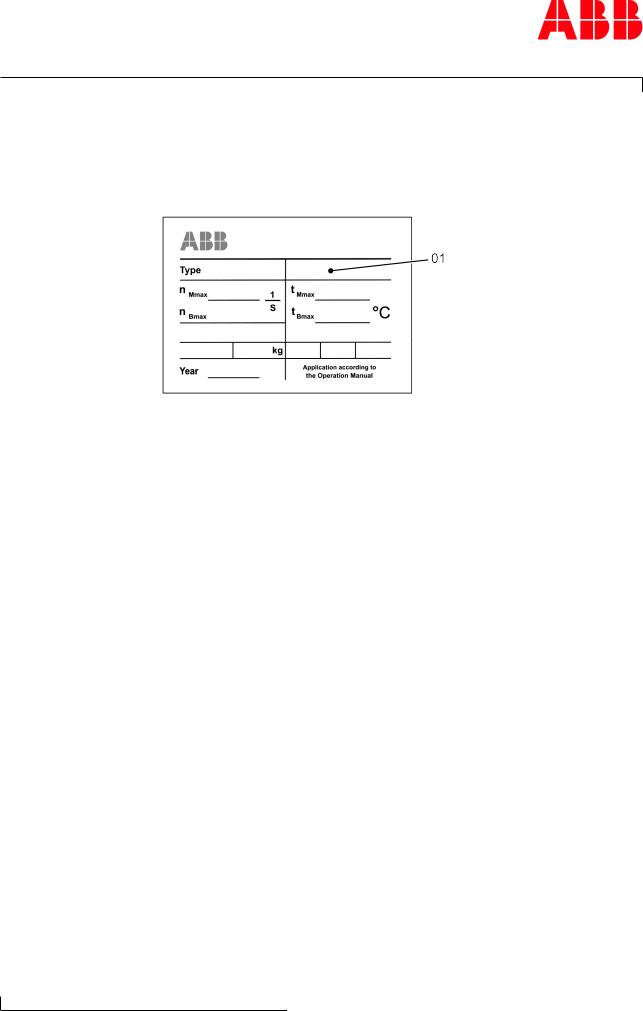
Operation Manual / TPS44-F.. - TPS61-F..
1 Preliminary remarks / 1.1 Purpose of this manual
1 Preliminary remarks
1.1 Purpose of this manual
This Operation Manual belongs to the turbocharger with the identical serial number (01), see the cover sheet of the Operation Manual and the turbocharger rating plate.
Operation Manual
This Operation Manual helps familiarise the user with the turbocharger from ABB Turbocharging and how to use it as intended.
It provides important information in order that the turbocharger can be operated safely, correctly and efficiently.
This Operation Manual complements and expands existing national regulations concerning work safety and accident prevention.
Target group
This Operation Manual is intended for engineers and qualified mechanics who are responsible for operating the engine and the turbocharger installed on it.
Availability of operation manual
An operation manual must be available at all times at the place where the turbocharger is used.
Everyone who operates or works on the turbocharger must have first read and understood the operation manual.
Page 3 / 113
© Copyright 2020 . All rights reserved. |
HZTL2412_EN |
Rev.G |
March 2020 |
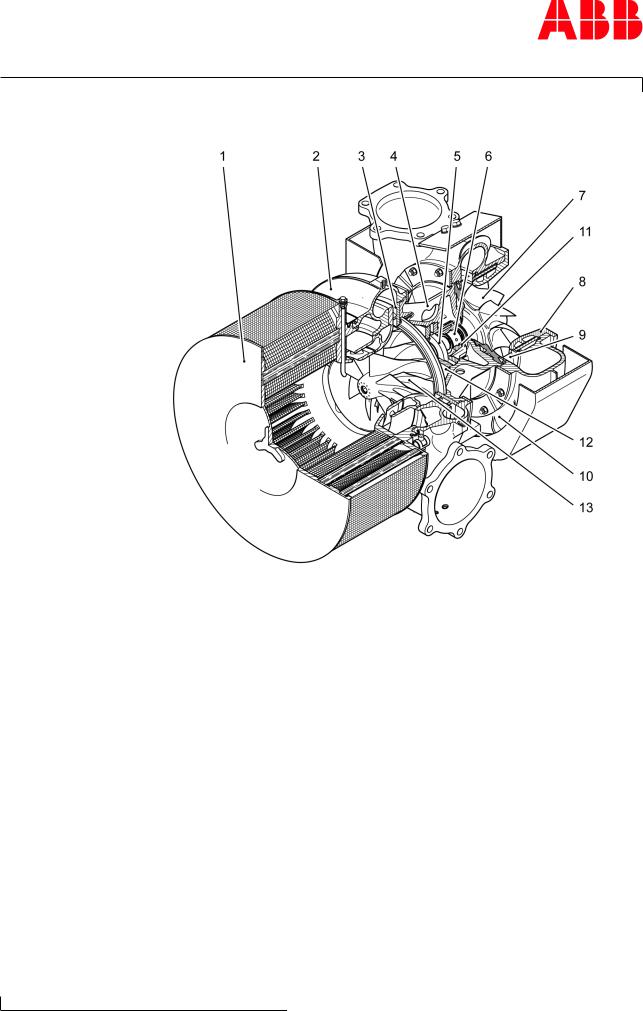
Operation Manual / TPS44-F.. - TPS61-F..
1Preliminary remarks / 1.2 Layout and function
1.2Layout and function
Page 4 / 113
1Suction branch / filter silencer |
8Gas outlet flange |
2Compressor casing |
9Nozzle ring |
3Diffuser |
10Turbine casing |
4Bearing casing |
11Turbine-end bearing flange |
5Axial thrust bearing |
12Compressor-end bearing |
|
flange |
6Radial plain bearing (visible only |
13Compressor wheel |
at turbine end) |
|
7Turbine |
|
© Copyright 2020 . All rights reserved. |
HZTL2412_EN |
Rev.G |
March 2020 |

Operation Manual / TPS44-F.. - TPS61-F..
1 Preliminary remarks / 1.2 Layout and function
Mode of operation
The turbocharger is a turbomachine consisting of the following main components:
¡Turbine
¡Compressor
These are mounted on a common shaft.
Exhaust gases from the diesel or gas engine flow through the turbine casing (10) and the nozzle ring (9) to impinge on the turbine (7).
The turbine (7) uses the energy contained in the exhaust gas to drive the compressor wheel (13). The compressor draws in fresh air, compresses it and then forces it into the engine's cylinders.
The exhaust gases escape into the ambient air through the exhaust gas pipe, which is connected to the gas outlet flange (8).
The air, which is necessary for operation of the diesel or gas engine and is compressed in the turbocharger, is drawn into the compressor wheel (13) through the suction branch or filter silencer (1). It then passes through the diffuser (3) and leaves the turbocharger through the outlet on the compressor casing (2).
The rotor runs in two radial plain bearings (6), which are located in the bearing flanges (11/12) between the compressor and the turbine. The axial thrust bearing (5) is located between the two radial plain bearings.
The bearings are connected to a central lubricating oil duct which is supplied by the engine's lubricating oil circuit. The oil outlet is always at the lowest point of the bearing casing (4).
Page 5 / 113
© Copyright 2020 . All rights reserved. |
HZTL2412_EN |
Rev.G |
March 2020 |
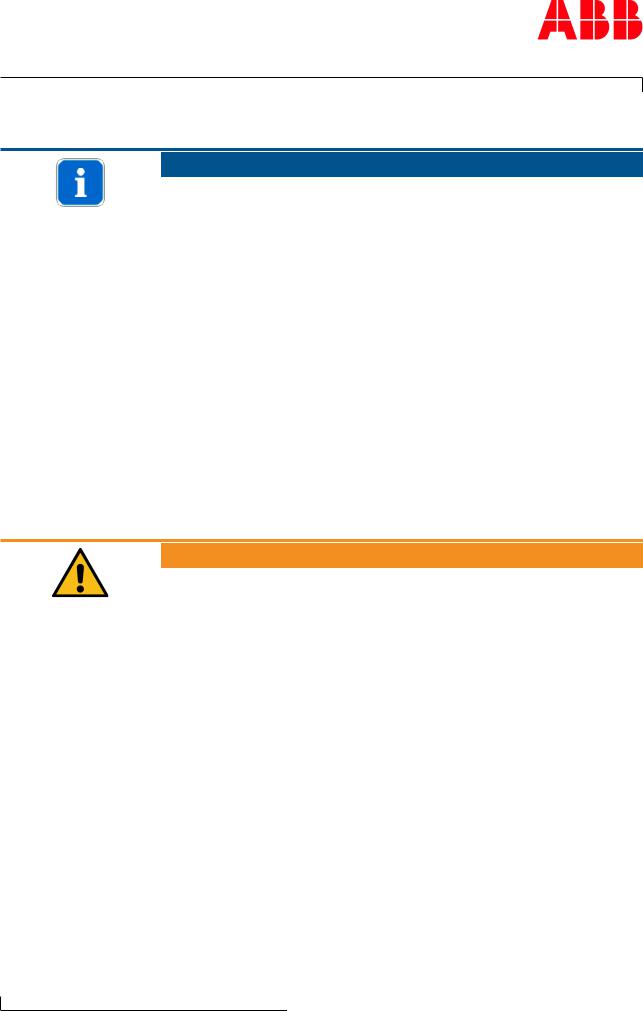
Page 6 / 113
Operation Manual / TPS44-F.. - TPS61-F..
1 Preliminary remarks / 1.3 Intended use of the turbocharger
1.3 Intended use of the turbocharger
NOTICE
|
This turbocharger supplied by ABB Turbocharging has been developed |
|
for use on diesel engines to generate the volume of air and the char- |
|
ging pressure required to operate the engine. |
|
The enginebuilder has provided ABB Turbocharging with information |
|
regarding the intended use of the engine, from which the operating |
|
limits specific to the turbocharger shown on the rating plate, such as |
|
operating speeds, temperatures, exchange intervals / replacement in- |
|
tervals, have been derived. |
|
Use in connection with a gas engine requires that the engine is not in- |
|
stalled in a potentially explosive environment and that precautions are |
|
taken to ensure that the engine room as a whole is classified as non-ex- |
|
plosive. |
|
Any other use is considered to be a special application, which must first |
|
be clarified with ABB Turbocharging. The manufacturer accepts no liab- |
|
ility for any other type of use. If the equipment is used for any other |
|
purpose, ABB Turbocharging reserves the right to reject all warranty |
|
claims. |
|
|
State of the art |
This turbocharger was built according to state-of-the-art technology |
|
and is operationally safe according to recognised safety regulations. |
 WARNING
WARNING
|
Improper operation and maintenance of the turbocharger can result in |
|
danger to life and limb of the user or third parties. In addition, im- |
|
proper use may cause damage to the machine. |
|
u The machine may be operated only by trained personnel. |
|
|
|
Use of the turbocharger as intended also includes observance of the in- |
|
stallation / fitting, disassembly / removal, operating, maintenance / ser- |
|
vicing and repair conditions specified by the manufacturer. Disposal reg- |
|
ulations set down by local authorities must be observed. |
Perfect condition |
The turbocharger may be installed only when in technically perfect condi- |
|
tion while observing the instructions given in the engine builder's |
|
manual. It may be used only for the intended purpose and operated in |
|
compliance with the operation manual. |
|
u Malfunctions which could affect safety must be eliminated immedi- |
|
ately. |
|
The manufacturer accepts no liability for any damage resulting from un- |
|
authorised alterations to the turbocharger. |
© Copyright 2020 . All rights reserved. |
HZTL2412_EN |
Rev.G |
March 2020 |
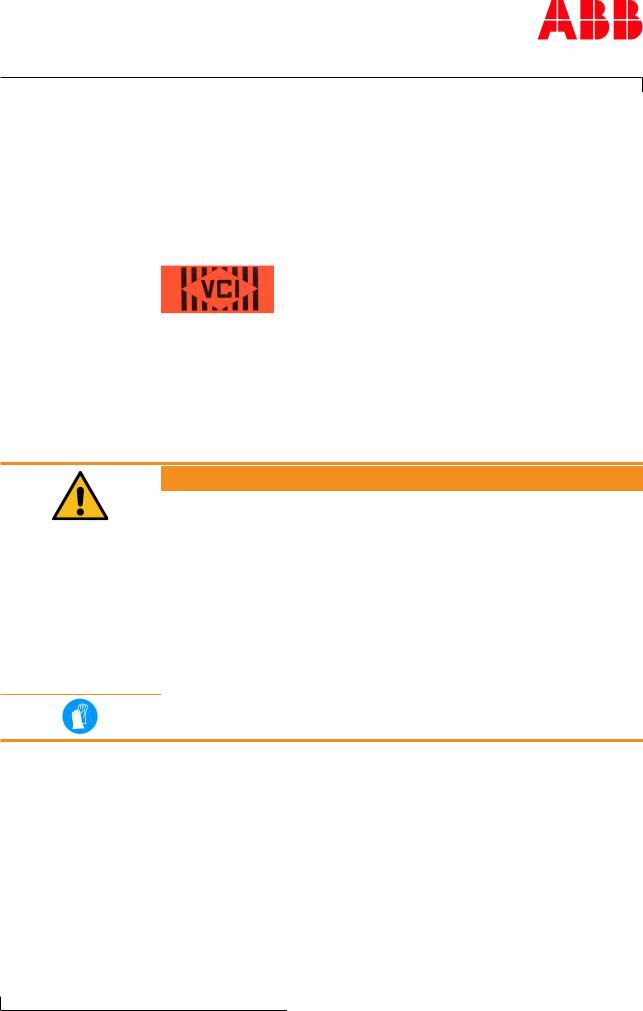
Operation Manual / TPS44-F.. - TPS61-F..
1 Preliminary remarks / 1.4 Storage of new turbochargers and spare parts
1.4 Storage of new turbochargers and spare parts
Storage of new turbochargers and spare parts up to 6 months
New turbochargers and spare parts from ABB Turbocharging can be stored in sealed packaging without additional mothballing measures for up to 6 months from the date of delivery (marked by the VCI label on the package).
Volatile Corrosion Inhibitor (VCI)
Only dry rooms in which the relative humidity is between 40…70 % and no condensation can form are suitable for storage.
Storage of new turbochargers and spare parts for more than 6
months (VCI)
 WARNING
WARNING
Protection of health when handling VCIs
VCI products are not hazardous in the sense of the Hazardous Substances Ordinance. Nevertheless, the following points are to be observed when handling VCIs:
uEnsure good room ventilation.
uDo not eat, drink or keep food at the workplace while working with VCIs.
uWear safety gloves.
uClean hands and face after working with VCIs.
uFor further information refer to www.branopac.com.
Wear safety gloves to protect against chemical hazards.
The following mothballing measures are required every 6 months:
uOpen the package.
uRemove the VCI corrosion protection emitter from the package and replace it with a new, identical VCI corrosion protection emitter. New VCI corrosion protection emitters can be obtained at www.branopac.com.
uDispose of the old VCI corrosion protection emitter in an environmentally compatible manner, professionally and in accordance with local regulations.
Page 7 / 113
© Copyright 2020 . All rights reserved. |
HZTL2412_EN |
Rev.G |
March 2020 |
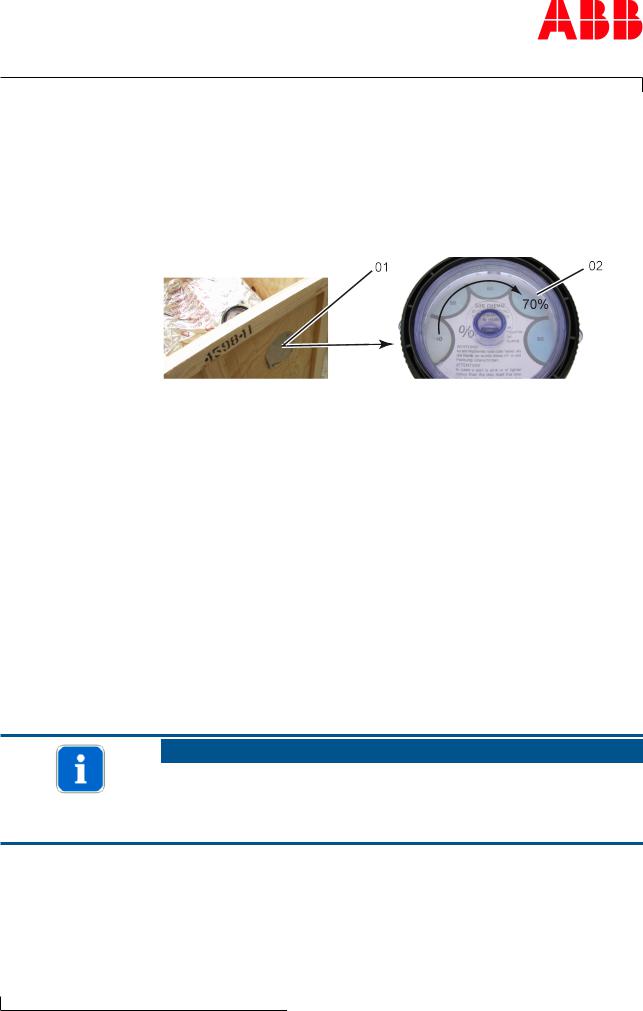
Page 8 / 113
Operation Manual / TPS44-F.. - TPS61-F..
1 Preliminary remarks / 1.4 Storage of new turbochargers and spare parts
uSeal the package. The better the external seal is designed, the more permanent the protection.
Long-term storage of turbochargers
The turbochargers will be prepared for prolonged storage by ABB Turbocharging on request. The package is equipped with a hygrometer (see illustration).
The following measures are required every 6 months:
uCheck the hygrometer (02) in the sight-glass. There is an opening (01) in the wooden crate which allows this check to be carried out. When the display field has changed colour at the 70% level, the maximum permissible humidity has been exceeded. In this case, the turbocharger must be inspected by an ABB Turbocharging Service Station and repacked.
uInspect the package for damage. If the package is damaged, the turbocharger must be inspected by an ABB Turbocharging Service Station and repacked.
After every 3 years the following work steps must be performed by an
ABB Turbocharging Service Station:
¡Inspect the component
¡Replace the desiccant agent
¡Repackage the component.
NOTICE
Turbocharger ready for operation
If the 70% field of the hygrometer (02) has not changed colour and the package is undamaged, the turbocharger can be put into operation without any prior inspection by an ABB Turbocharging Service Station.
Unpacking the turbochargers
The corrosion protection effect ends after the material is unpacked from the VCI package.
To avoid the formation of condensation, the surroundings and the content of the package must have the same temperature during unpacking.
© Copyright 2020 . All rights reserved. |
HZTL2412_EN |
Rev.G |
March 2020 |
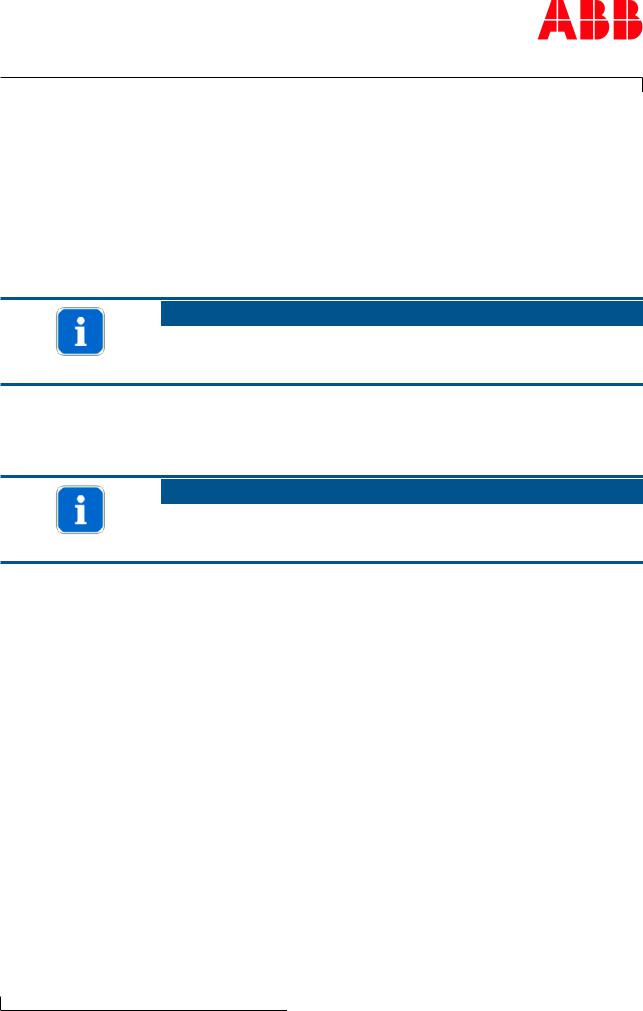
Operation Manual / TPS44-F.. - TPS61-F..
1 Preliminary remarks / 1.5 Essential information
1.5 Essential information
Organisational measures
In addition to the Operation Manual, the general statutory regulations for the prevention of accidents and protection of the environment are also to be observed.
This also applies for the provision and wearing of personal protective equipment.
NOTICE
The manner in which personnel work on and with the turbocharger with regard to safety and risks is to be checked on a regular basis in accordance with the Operation Manual.
uIf the turbocharger shows modifications affecting safety or any corresponding operating behaviour, it must be shut down immediately by stopping the engine. The malfunction must be reported to the person or department responsible.
NOTICE
Any modifications, additions or conversions made to the turbocharger that could impair safety require the prior approval of ABB Turbocharging.
Page 9 / 113
© Copyright 2020 . All rights reserved. |
HZTL2412_EN |
Rev.G |
March 2020 |

Page 10 / 113
Operation Manual / TPS44-F.. - TPS61-F..
1 Preliminary remarks / 1.5 Essential information
Original parts and safety
Original parts and accessories are specially designed for the turbocharger supplied by ABB.
 WARNING
WARNING
Use original parts
Operation of the turbocharger with non-original parts can impair the safety of the turbocharger and can cause serious damage to property and injury to personnel.
u Only use original parts from ABB.
ABB accepts no liability for any damage resulting from the use of nonoriginal parts and corresponding accessories.
Competence of personnel
The turbocharger must only be operated and serviced by trained and authorised personnel. Basic mechanical training is a prerequisite.
Design variants
This document is valid for different design variants of turbochargers. There may be sections and descriptions of components that are not relevant for a specific turbocharger variant.
ABB Turbocharging Service Stations will be happy to provide information on questions regarding a design variant (see Contact information at www.abb.com/turbocharging).
Accuracy of illustrations
The illustrations in this document are general in nature and intended for ease of understanding. Differences in detail are therefore possible.
Registered Trademarks
Registered trademarks of external companies are used in this document.
The trademarks are marked with ®.
© Copyright 2020 . All rights reserved. |
HZTL2412_EN |
Rev.G |
March 2020 |

Operation Manual / TPS44-F.. - TPS61-F..
1 Preliminary remarks / 1.6 Symbols and definitions
1.6 Symbols and definitions
The following symbols are used in the documents:
w Prerequisite
u Work step
¡ Enumeration, first level
- Enumeration, second level
→ Refers to a page number
Definition of notes
NOTICE
Note
A note provides suggestions which facilitate the work on the product.
Definition of mandatory signs
Mandatory signs show the protective equipment to be worn for a task. The mandatory signs are described in chapter Safety and must be complied with.
Definition of caution / warning
The caution and warning signs are described in the chapter Safety.
ABB Turbocharging
ABB Switzerland Ltd, Turbocharging is identified as ABB Turbocharging in this document.
Official service stations of ABB Turbocharging
Official service stations are regularly audited and certified by ABB Turbocharging. See also chapter Contact information →13.
Page 11 / 113
© Copyright 2020 . All rights reserved. |
HZTL2412_EN |
Rev.G |
March 2020 |
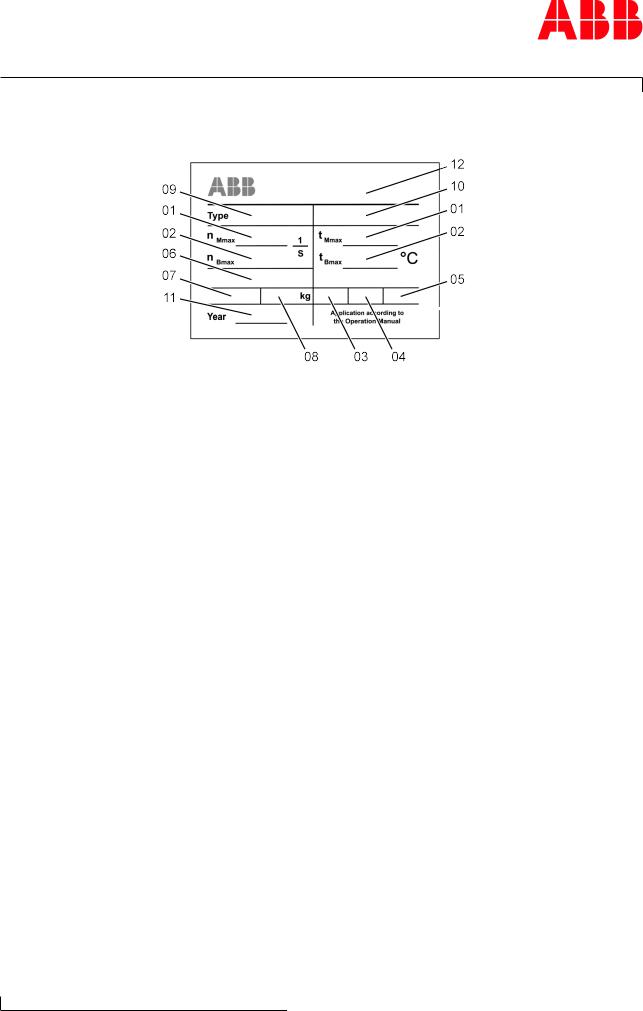
Operation Manual / TPS44-F.. - TPS61-F..
1Preliminary remarks / 1.7 Turbocharger rating plate
1.7Turbocharger rating plate
Page 12 / 113
Operating limits |
01 |
Turbocharger operating limits at engine overload (110 %). |
|
|
|
Only when operating in the test rig unless otherwise agreed with the |
|
|
|
enginebuilder. |
|
|
02 |
Turbocharger operating limits during operation |
|
Recommended inspection |
03 |
Inspection interval for plain bearings in 1000 h |
|
and replacement intervals |
04 Replacement interval for compressor in 1000 h |
||
for turbocharger compon- |
|||
05 |
Replacement interval for turbine in 1000 h |
||
ents |
|||
Further information |
06 |
Part number for customer |
|
07 |
Designation of special design |
|
08 |
Turbocharger weight in kg |
|
09 |
Turbocharger type |
|
10 |
Serial number |
|
11 |
Year of turbocharger construction |
|
12 |
Manufacturing plant |
© Copyright 2020 . All rights reserved. |
HZTL2412_EN |
Rev.G |
March 2020 |
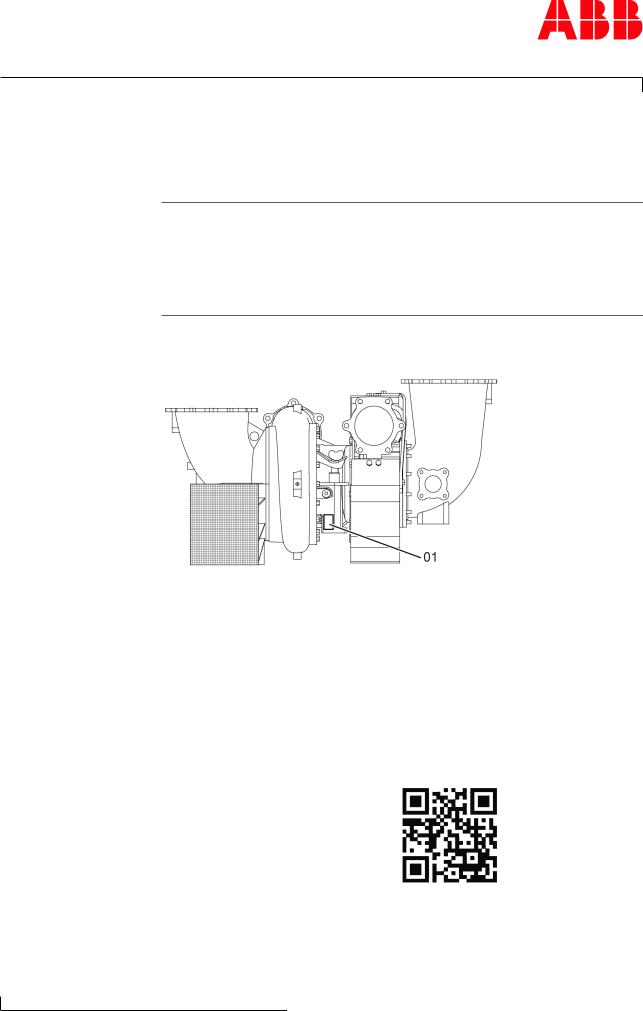
Operation Manual / TPS44-F.. - TPS61-F..
1Preliminary remarks / 1.8 Contact information
1.7.1Explanation of the rating plate
The recommended replacement intervals and the corresponding operational limits are jointly defined with the engine manufacturer. This information is specific to the system.
Operation above the indicated values nBmax, tBmax can considerably shorten the recommended replacement intervals. In such cases, we recommend that you contact the nearest official ABB Turbocharging service station. nMmaxand tMmax normally apply only when running at overload (110%) during
trials on the engine test bed. Operation above nMmax and tMmax is not permitted.
Non-observance of the recommended replacement intervals increases the risk of unpredictable component failures.
1.7.2Positions of the rating plates
Page 13 / 113
One rating plate (01) each is attached on the left and the right side of the turbocharger bearing casing.
1.8 Contact information
Contact information for the official service stations of ABB Turbocharging is available online.
u Scan the QR code to access our website.
ABB Switzerland Ltd, Turbocharging
Bruggerstrasse 71a
CH-5401 Baden
Switzerland
www.abb.com/turbocharging
© Copyright 2020 . All rights reserved. |
HZTL2412_EN |
Rev.G |
March 2020 |

Page 14 / 113
Operation Manual / TPS44-F.. - TPS61-F..
2 Safety / 2.1 Introduction
2 Safety
2.1 Introduction
Turbochargers manufactured by ABB are state of the art and comply with the pertinent safety and health-protection requirements that applied when the turbocharger was manufactured. Consequently, the turbocharger is safe to operate. Nevertheless, during turbocharger operation and when working on the turbocharger, residual risks can exist which:
¡originate from the turbocharger itself and its accessories
¡originate from the operating and auxiliary materials used
¡are the consequence of insufficient observance of the safety instructions
¡are the consequence of unsatisfactory and improper execution of maintenance and inspection work.
The operating company is responsible for access to the turbocharger as well as the organisational measures that regulate the safe handling of the turbocharger by its personnel.
All instructions contained in this chapter must be observed for safe and trouble-free operation of the turbocharger and during all work on the turbocharger.
All further safety instructions contained and specifically identified in every chapter of this manual (see section Definition of Safety Instructions) must also be observed.
2.2 CE conformity
Information
ABB turbochargers fulfil Directive 2006/42/EC on machinery and are considered partly completed machinery in the sense of Article 2 g.
© Copyright 2020 . All rights reserved. |
HZTL2412_EN |
Rev.G |
March 2020 |

Operation Manual / TPS44-F.. - TPS61-F..
2 Safety / 2.3 Definition of mandatory signs
2.3 Definition of mandatory signs
To be worn at all times
Protective clothing |
Safety footwear to pro- |
|
tect against mechanical |
|
hazard and risk of fall- |
|
ing |
|
|
|
|
To be worn according to the specific work
Safety glasses |
Safety goggles |
Safety gloves against |
Respiratory mask |
- Mechanical hazard |
against |
- Chemical hazard |
- Dusts |
- Thermal hazard |
- Gases |
|
|
Safety helmet |
Ear protection |
2.4 Definition of Safety instructions
The following symbols and terms used in this manual concern safety or refer to possible hazards:
 WARNING
WARNING
Definition of warning
Serious personal injuries and even accidents with fatal consequences may occur if work and operating instructions marked with this symbol and the word WARNING are either not followed or not followed precisely.
u Warning signs must be observed at all times.
 CAUTION
CAUTION
Definition of caution
Serious machine or property damage may occur if work and operating instructions marked with this symbol and the word CAUTION are either not followed or not followed precisely.
u Caution signs must be observed at all times.
Page 15 / 113
© Copyright 2020 . All rights reserved. |
HZTL2412_EN |
Rev.G |
March 2020 |
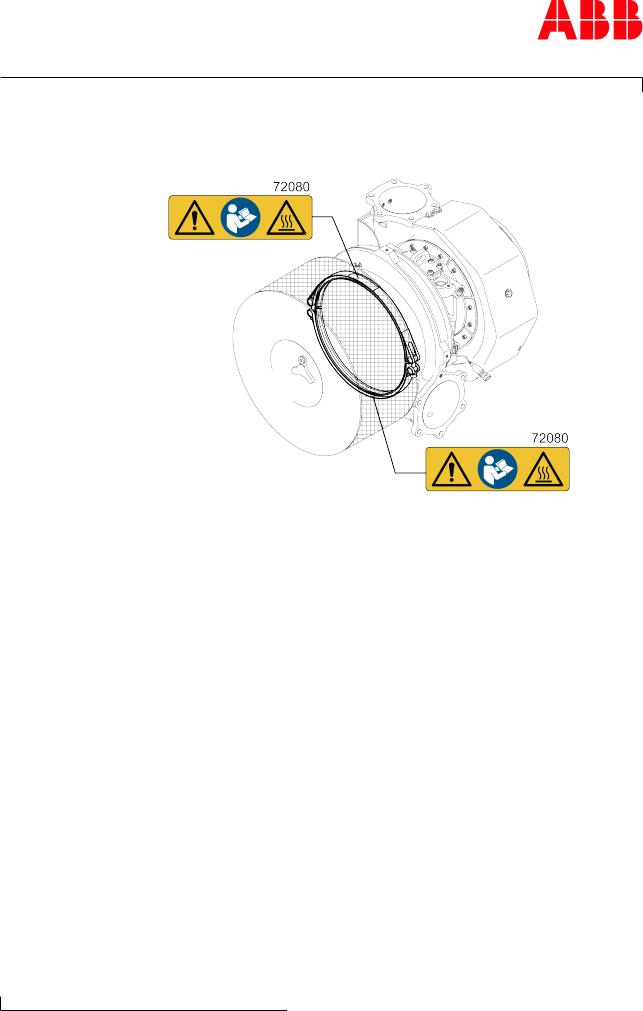
Page 16 / 113
Operation Manual / TPS44-F.. - TPS61-F..
2 Safety / 2.5 Warning plates on the turbocharger
2.5 Warning plates on the turbocharger
Warning plates are attached to the turbocharger at the following places:
If warning plates are not present at the intended places or are not legible, then proceed as follows:
uOrder new warning plates from ABB Turbocharging Service Stations.
uRemove unreadable warning plates.
uClean and degrease surfaces provided for warning plates.
uAttach new warning plates.
Uninsulated turbochargers
When uninsulated turbochargers are delivered to the engine builder, the warning plates must be subsequently attached to the insulation. This is the responsibility of the engine builder.
2.6 Safe operation and maintenance
The instructions specified in this section are for the safety of personnel. Together with the instructions in the Hazards during operation and maintenance section, they allow the user to safely use the turbocharger.
© Copyright 2020 . All rights reserved. |
HZTL2412_EN |
Rev.G |
March 2020 |
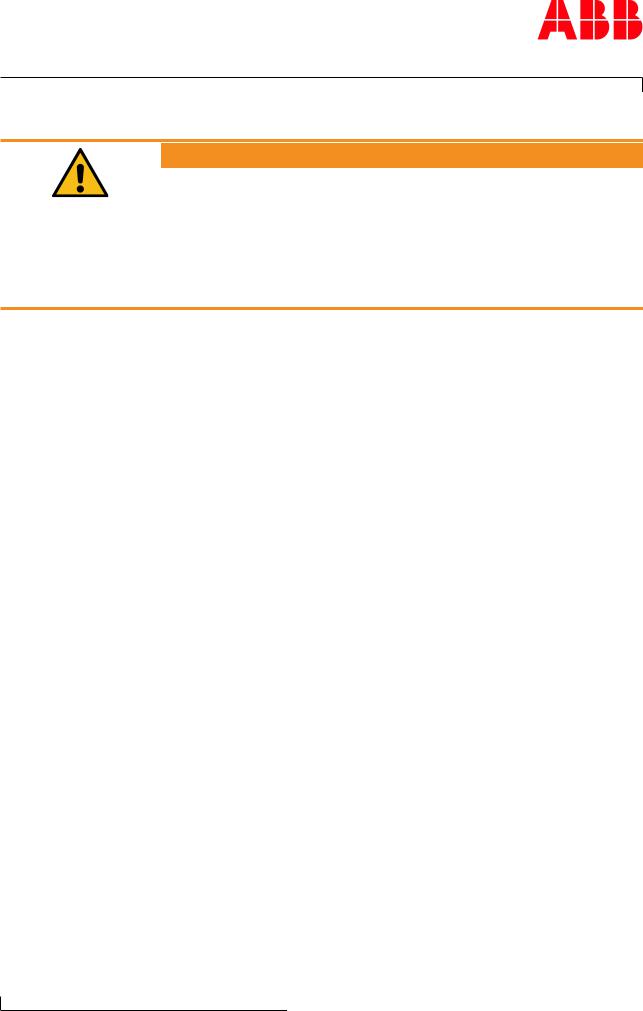
Operation Manual / TPS44-F.. - TPS61-F..
2 Safety / 2.6 Safe operation and maintenance
Work safety and work area safety
 WARNING
WARNING
Risk of falling
There is the risk that someone can fall when working on the turbocharger.
uDo not climb on the turbocharger or on parts attached to it or use these as climbing aids.
uWhen working at levels above the head, use climbing aids and work platforms suitable for this purpose.
uObserve all general regulations for the prevention of accidents.
uDo not work on the turbocharger if you are under physical or mental stress.
uWork only with suitable tools as well as equipment and working materials that are in perfect condition.
uElectric tools must be solidly earthed, and connecting cables may not be damaged.
uKeep the workplace clean, clear away loose objects and remove obstacles on the floor.
uKeep the floor, equipment and the turbocharger clean.
uHave oil binding materials ready at hand and keep oil catch pans ready or in position
uEliminate leaks.
uKeep fire-protection materials and fire-extinguishing equipment ready.
Welding work close to the turbocharger
uIf welding work is being carried out in the vicinity of the turbocharger, cover the filter silencer so that the filter mat is not damaged.
uRemove combustible objects and substances out of the range of flying sparks.
uCover all connections on the turbocharger so that no foreign objects can get into the turbocharger.
uWear personal protective equipment (PPE) for welding operations.
Page 17 / 113
© Copyright 2020 . All rights reserved. |
HZTL2412_EN |
Rev.G |
March 2020 |
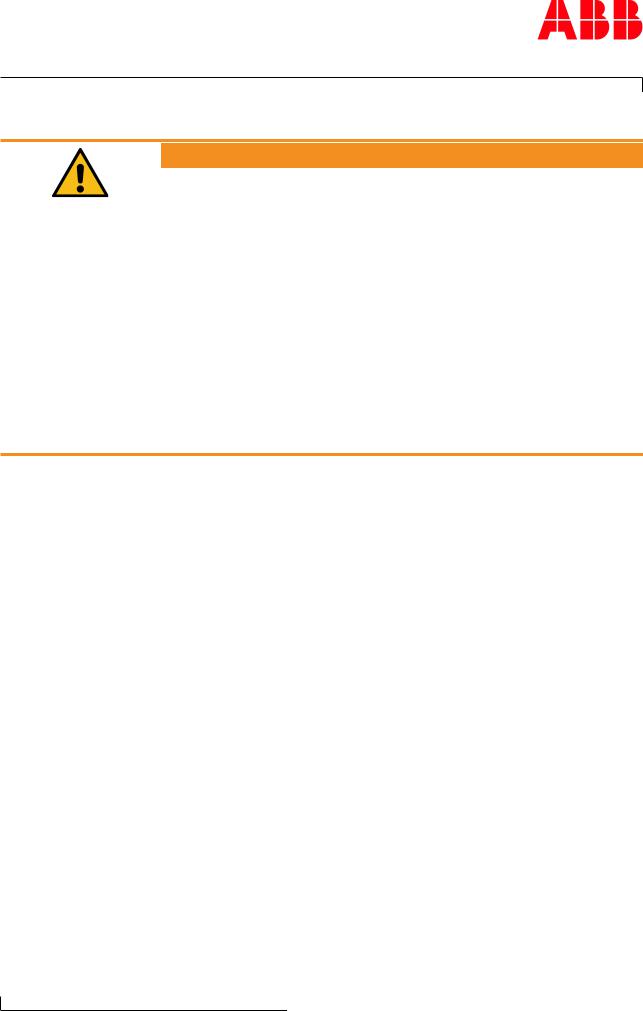
Page 18 / 113
Operation Manual / TPS44-F.. - TPS61-F..
2 Safety / 2.6 Safe operation and maintenance
Safety during start-up / commissioning and operation
 WARNING
WARNING
The turbine casing insulation of the TPS44-F supplied by ABB is also
burst protection
Serious personal injuries or fatal accidents can occur, if the turbine casing insulation of the TPS44-F supplied by ABB is removed. The burst protection is integrated into the turbine casing insulation of the TPS44- F supplied by ABB.
Separate burst protection is fitted to TPS44-F turbochargers that have been ordered from ABB without insulation.
uNever operate TPS44-F turbochargers that have been supplied by ABB with insulation if this insulation from ABB is not in place.
uNever operate turbochargers without burst protection. If the insulation from ABB is not in place, the separate burst protection (57200) must be fitted before operation (see View of turbocharger showing part numbers →110).
uBefore starting work, carry out visual inspection of working area.
uRemove any obstacles and objects lying around.
uBefore start-up / commissioning, check all pipes from and to turbocharger for damage and leaks.
uDon't work in any way that could impair safety when working on turbocharger.
uAfter about every 12 hours of operation or at least once a day, inspect turbocharger for visible damage and defects.
uImmediately report any damage or changes in operational performance to person responsible.
uIf damage is discovered, immediately shut down turbocharger and secure it against inadvertent or unauthorized use.
uWhen switching on auxiliary power sources (hydraulics, pneumatics, electricity, water), keep an eye open for any hazards resulting from supplying these power sources.
Safety during cleaning
If cleaning agents or solvents are used for cleaning, the corresponding material safety data sheet and the safety instructions in section "Hazards due to operating and auxiliary materials" must be observed.
uObserve the material safety data sheet for the cleaning agent or solvent.
uWear personal protective equipment (PPE) according to the material safety data sheet.
© Copyright 2020 . All rights reserved. |
HZTL2412_EN |
Rev.G |
March 2020 |
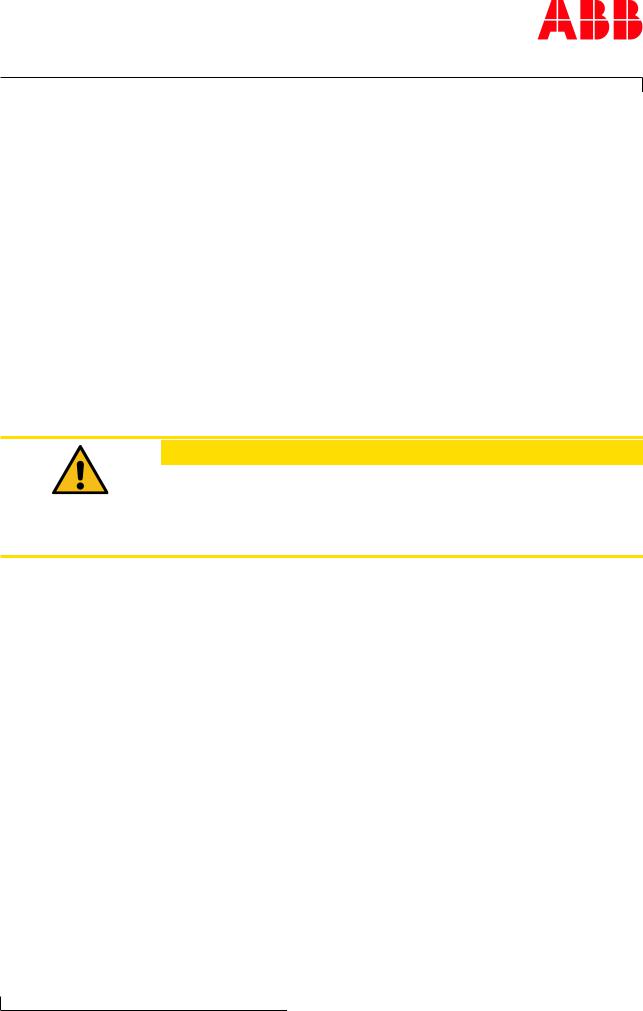
Operation Manual / TPS44-F.. - TPS61-F..
2 Safety / 2.6 Safe operation and maintenance
uInspect the electric cables for abrasion and damage before and after your cleaning work.
Safety during disassembly, assembly, maintenance and
troubleshooting
uAlways perform the specified adjustments, servicing as well as inspection work and observe inspection intervals.
uInform operating personnel about all service and repair work before beginning.
uBefore opening a cover or removing a protective device on a turbocharger, the engine must be switched off and the turbocharger must have come to a standstill.
uEnsure that the supply of oil is interrupted, especially with an external oil supply.
uPut the engine into operation only after all parts have been refitted properly.
 CAUTION
CAUTION
Mechanical work on the turbocharger
Possible damage to or destruction of components on the turbocharger.
uPerform only those tasks that are described in this manual.
uPerform work only for which training has been carried out.
Safety when taking out of operation or preparing for mothballing
uSecure the rotor so it cannot turn. The rotor can turn on its own from the force of the stack draught.
uClean the turbocharger before mothballing it.
uObserve the material safety data sheet for the cleaning and mothballing agents.
uWear personal protective equipment (PPE) according to the material safety data sheet.
Page 19 / 113
© Copyright 2020 . All rights reserved. |
HZTL2412_EN |
Rev.G |
March 2020 |
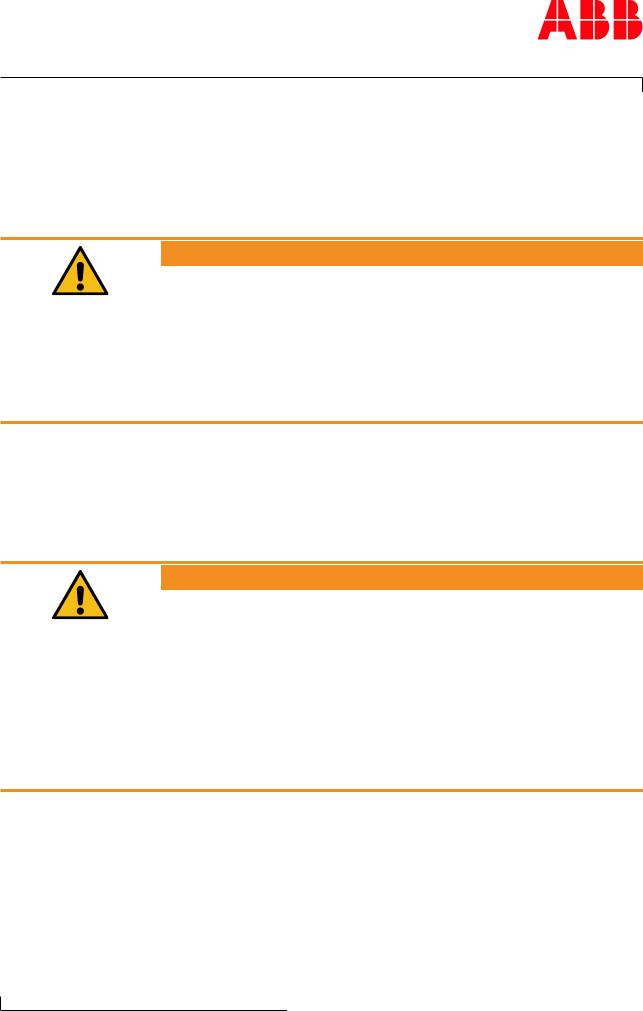
Page 20 / 113
Operation Manual / TPS44-F.. - TPS61-F..
2 Safety / 2.7 Hazards during operation and maintenance
2.7 Hazards during operation and maintenance
Mechanical hazards during operation
During normal operation, no mechanical hazards emanate from the turbocharger if it has been installed properly.
 WARNING
WARNING
Risk of injury
Contact with rotating parts can lead to serious injuries. The turbocharger must never be operated without a filter silencer or an air suction branch. When the engine is at a standstill, the rotor can turn on its own because of stack draught.
uOperate the turbocharger in accordance with instructions.
uDuring maintenance work, secure the rotor against unintentional rotation.
Mechanical hazards when working on the turbocharger
During maintenance work, various risks can occur through the improper handling of components, through the non-observance of work instructions, due to inadequate care or as a consequence of insufficient training.
 WARNING
WARNING
Mechanical hazard
Severe injuries to personnel or fatal accidents can be caused by mechanical influences as a consequence of hazardous and inadequate operational procedures.
uObserve the general rules for occupational safety and prevention of accidents.
uEnsure workplace safety.
uOnly perform operations that are described in this chapter.
uOnly perform operations for which you have previously received instruction or training.
© Copyright 2020 . All rights reserved. |
HZTL2412_EN |
Rev.G |
March 2020 |
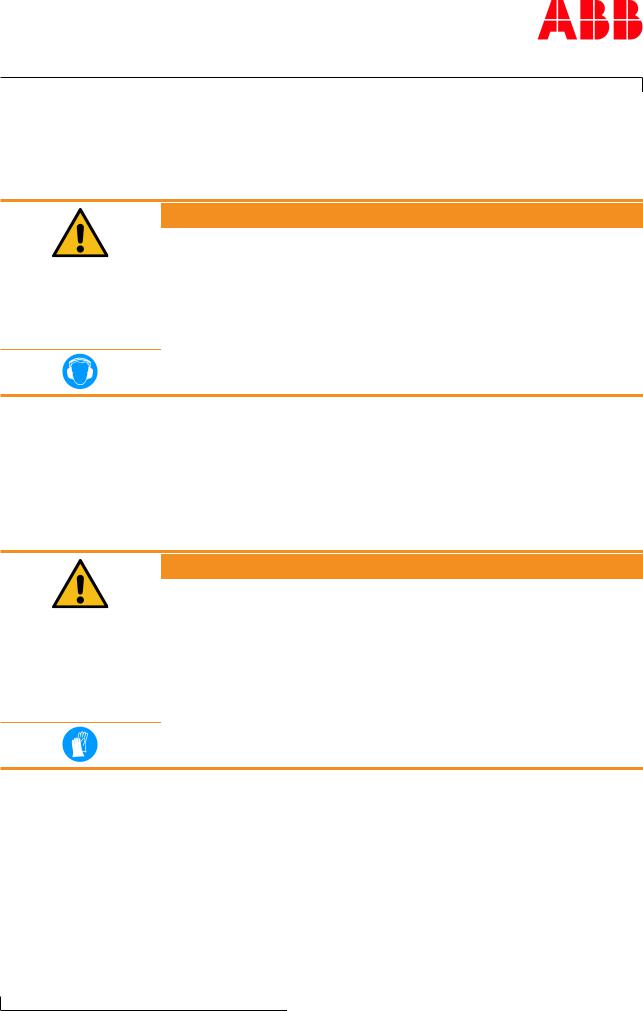
Operation Manual / TPS44-F.. - TPS61-F..
2 Safety / 2.7 Hazards during operation and maintenance
Hazards due to noise
The development of noise during operation is influenced by the installation and operating conditions. Noise with a sound pressure level exceeding 85 dB(A) is harmful.
 WARNING
WARNING
Hazards due to noise
Noise can cause impaired hearing, damage to health, mental disturbances, diminished attention and irritation.
uAlways wear ear protection when the engine is running.
uWhen the sound pressure level is above 85 dB(A), always wear ear protection.
Wear ear protection.
Hazards due to hot surfaces and substances
During operation, turbocharger surfaces and attached parts as well as operating materials (lubricating oil) become hot. The surface temperature is dependent on the effectiveness of the insulation being used. The temperature can become high enough so that it falls into ranges where burns are possible.
 WARNING
WARNING
Risk of burning
Touching hot surfaces or contact with hot operating materials can lead to serious burns.
uDo not touch hot surfaces and heed the warning plate on the turbocharger.
uWear heat-resistant safety gloves and protective clothing.
uAllow the turbocharger to cool down before carrying out any work.
Wear safety gloves to protect against thermal hazards.
Page 21 / 113
© Copyright 2020 . All rights reserved. |
HZTL2412_EN |
Rev.G |
March 2020 |
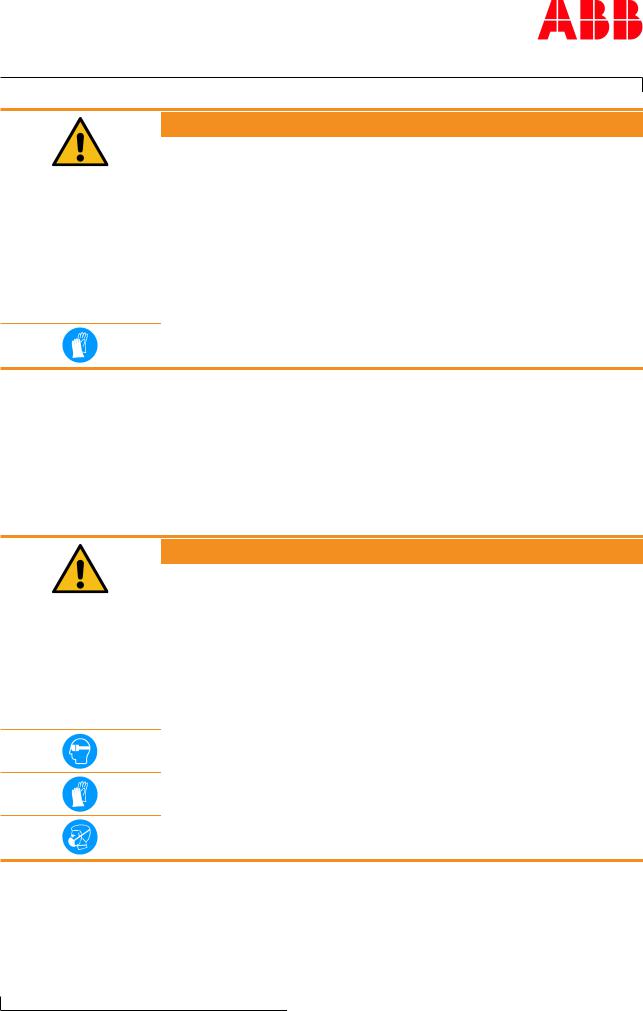
Page 22 / 113
Operation Manual / TPS44-F.. - TPS61-F..
2 Safety / 2.7 Hazards during operation and maintenance
 WARNING
WARNING
Hot surfaces on uninsulated turbochargers
Uninsulated turbochargers can cause serious personal injuries (burns).
The turbocharger is supplied with or without insulation in accordance with the purchase order received from the enginebuilder. If supply is without insulation, the enginebuilder is responsible for providing the turbocharger with proper insulation and for providing protection against contact with hot surfaces.
uCompliance with the instructions and specifications given by the enginebuilder to protect against hot turbocharger surfaces is compulsory.
Wear safety gloves to protect against thermal hazards.
Hazards due to operating and auxiliary materials
Operating and auxiliary materials are substances used for operation or the execution of maintenance work. Oils, greases, coolants, cleaning agents and solvents, acids, etc. can be regarded as hazardous materials. Operating and auxiliary materials can be combustible and easily ignited.
 WARNING
WARNING
Handling operating and auxiliary materials
Ingestion or inhalation of vapours of operating and auxiliary materials or contact with such can cause damage to health.
uAvoid inhalation and contact with the skin.
uEnsure good ventilation.
uObserve details in the safety data sheets of the operating and auxiliary materials.
uObserve local laws.
Wear safety goggles.
Wear safety gloves to protect against chemical hazards.
Wear a respiratory mask to protect against gases.
© Copyright 2020 . All rights reserved. |
HZTL2412_EN |
Rev.G |
March 2020 |
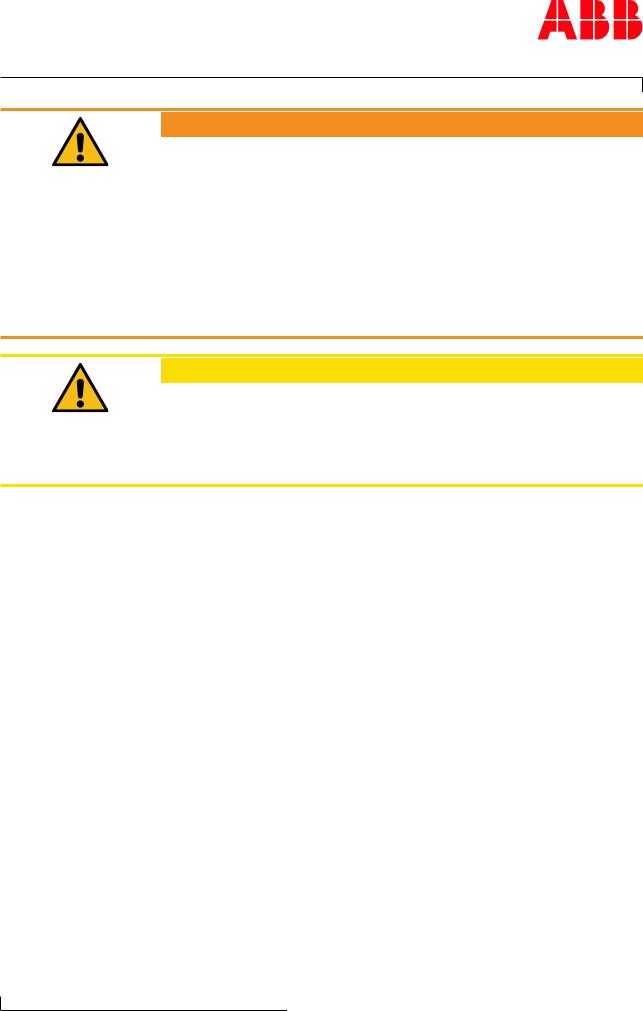
Operation Manual / TPS44-F.. - TPS61-F..
2 Safety / 2.7 Hazards during operation and maintenance
 WARNING
WARNING
Risk of fire, explosion
Flammable and combustible operating materials and supplies can catch fire or resulting vapours can lead to an explosion.
uObserve the details in the material safety data sheets of the operating and auxiliary materials.
uComply with local legislation.
uDo not allow any exposed flame or ignition source during cleaning work.
uCarry out cleaning in the open or provide sufficient aeration and ventilation.
 CAUTION
CAUTION
Risk of environmental damage
The escape of operating and auxiliary materials into the atmosphere or contamination of the ground and water due to improper disposal can lead to environmental damage.
uHandle operating and auxiliary materials carefully.
uHeed the instructions for use, safety data sheets and hazard notices on the containers of the operating and auxiliary materials.
uWear appropriate protective clothing.
uAvoid inhalation and contact with the skin.
uEnsure that the work space is adequately ventilated.
uSeal containers tightly immediately after use and put them away.
uCollect used working and auxiliary materials safely, store them separately in suitable containers and dispose of them properly and in an environmentally compatible manner in accordance with statutory regulations.
uIn the event of leaks or after spilling, immediately spread a suitable binding agent and dispose of it properly and in an environmentally compatible manner in accordance with statutory regulations.
Page 23 / 113
© Copyright 2020 . All rights reserved. |
HZTL2412_EN |
Rev.G |
March 2020 |
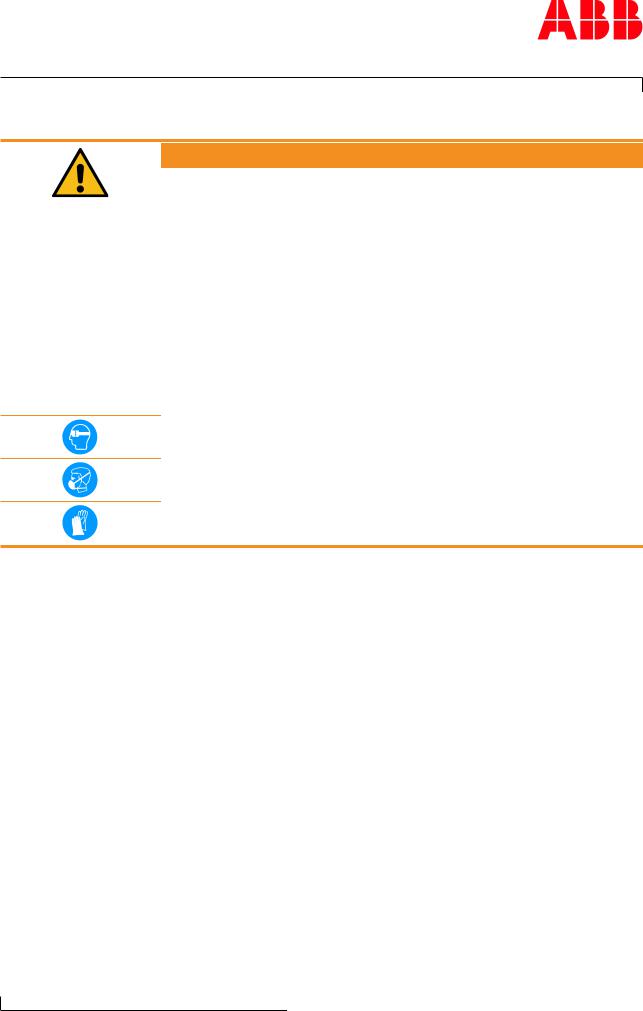
Page 24 / 113
Operation Manual / TPS44-F.. - TPS61-F..
2 Safety / 2.7 Hazards during operation and maintenance
Hazards when handling insulating materials
 WARNING
WARNING
Hazards due to insulating materials
Dust and fibres from insulating materials can cause damage to health or irritations. Unsuitable, combustible insulating materials signify a fire hazard.
uUse only suitable, non-combustible insulating materials.
uEnsure that the work area is well ventilated.
uAvoid stirring up dust.
uUse tools and processes which keep dust to a minimum.
uRemove packing materials only in the work area.
uTake particular care when removing old insulating materials.
uDispose of insulating materials properly and in an environmentally compatible way in accordance with applicable local regulations.
Wear safety goggles.
Wear a respiratory mask to protect against dusts.
Wear safety gloves to protect against chemical hazards.
uUse only suitable, non-combustible insulating materials.
uEnsure that the work area is well ventilated.
uWear suitable work clothing (safety glasses, respiratory mask).
uAvoid stirring up dust.
uUse tools and processes which keep dust to a minimum.
uRemove packing materials only in the work area.
uTake particular care when removing old insulating materials.
uDispose of insulating materials properly and in an environmentally compatible way in accordance with applicable local regulations.
© Copyright 2020 . All rights reserved. |
HZTL2412_EN |
Rev.G |
March 2020 |
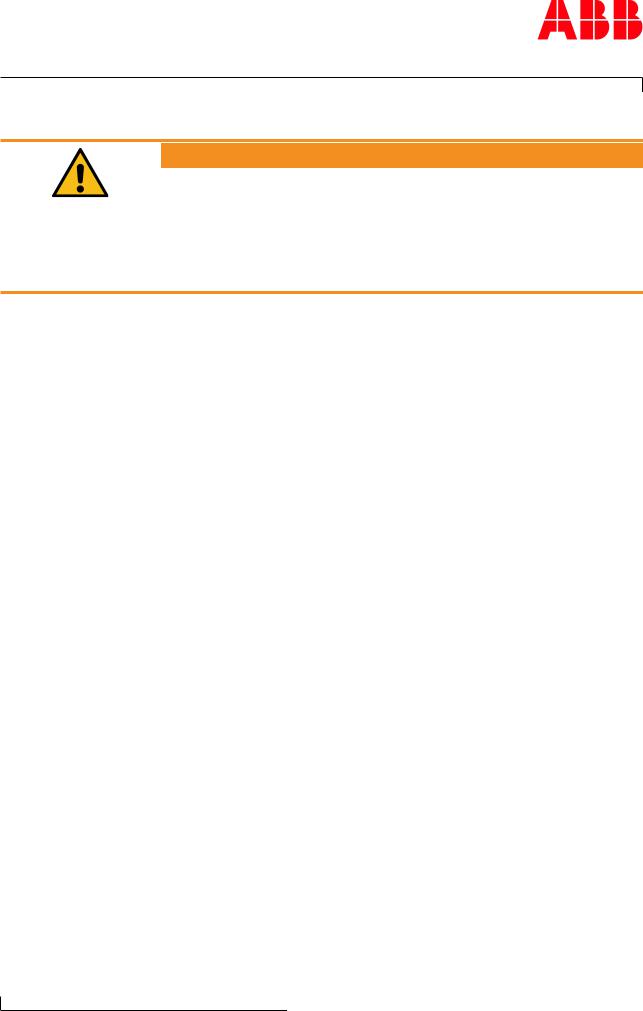
Operation Manual / TPS44-F.. - TPS61-F..
2 Safety / 2.8 Deflagration on gas engines
Hazards due to electrical components
 WARNING
WARNING
Hazards due to electrical components
Electrical components operate with voltages which can present hazards to humans.
uAll work on or with electrical components may only be performed by trained specialists.
uHeed any country-specific regulations.
2.8Deflagration on gas engines
ABB turbochargers can withstand a deflagration with a transient pressure increase of 12 bar.
ABB Turbocharging recommends that, following a deflagration event, the turbocharger undergoes an inspection of the following points:
¡Position of the turbine and compressor casings to the bearing casing
¡Shifting of the bearing casing in relation to the bracket
¡Cracks in casings
If during external inspection anomalies are found or if a particularly strong deflagration event has taken place, it is also recommended to check the bearings of the turbochargers before the next start. This inspection and evaluation must be carried out by an ABB Turbocharging Service Station.
Page 25 / 113
© Copyright 2020 . All rights reserved. |
HZTL2412_EN |
Rev.G |
March 2020 |
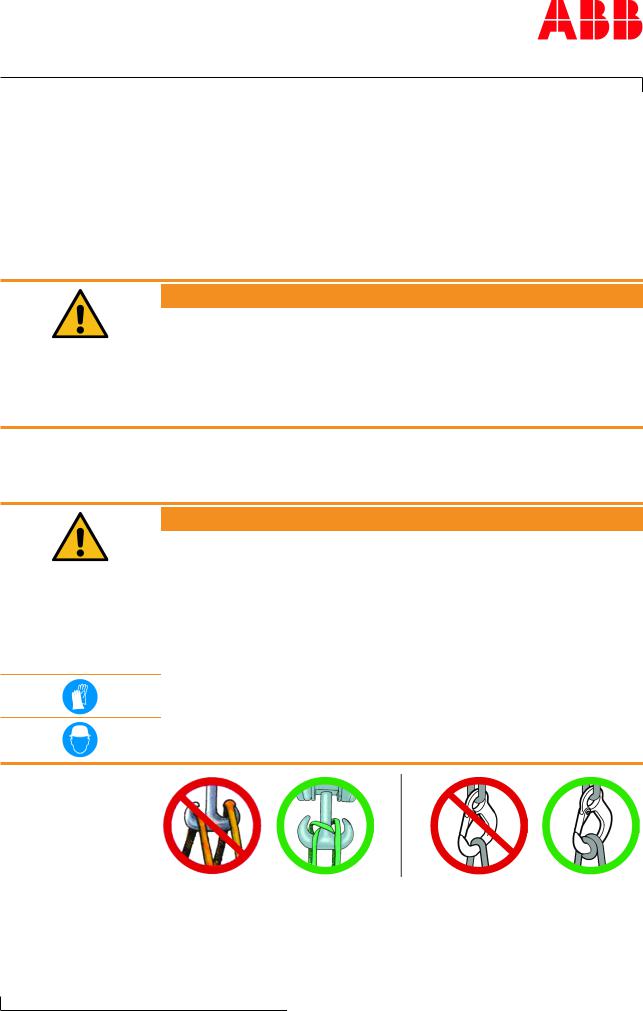
Page 26 / 113
Operation Manual / TPS44-F.. - TPS61-F..
2 Safety / 2.9 Periodic checking of the pressure vessel
2.9 Periodic checking of the pressure vessel
The pressure vessels used by ABB, such as those for wet or dry cleaning, are so-called "simple pressure vessels".
¡The locally applicable legal regulations regarding periodic checks of the pressure vessels must be observed.
¡The operating company is responsible for the safe operation of the pressure vessel.
 WARNING
WARNING
Danger due to pressure vessels
The operating company must make sure the pressure vessels are in proper working condition and monitor them. Necessary repair or maintenance work must be carried out without delay and the required safety precautions must be taken.
u Pressure equipment must not be operated if it has defects.
2.10Lifting loads
 WARNING
WARNING
Suspended loads
Loads not suspended in compliance with regulations may lead to personal injury or accidents with fatal consequences.
uLoads must always be fastened to technically perfect lifting gear with sufficient loading capacity.
uMake sure the load is suspended properly on the crane hook.
uDo not let anyone stand beneath a suspended load.
Wear safety gloves to protect against mechanical hazards.
Wear safety helmet.
© Copyright 2020 . All rights reserved. |
HZTL2412_EN |
Rev.G |
March 2020 |
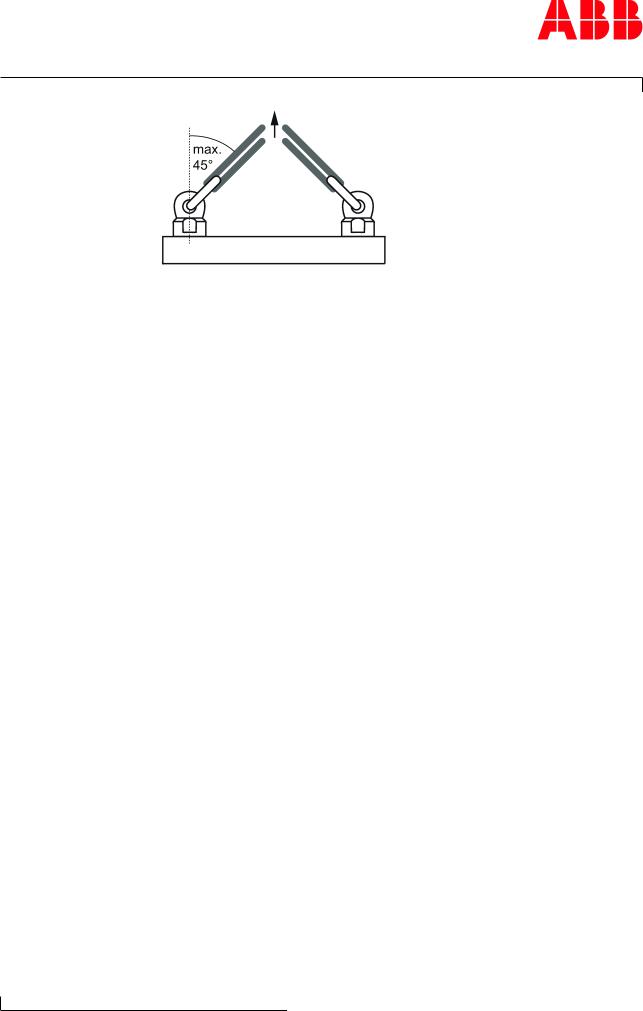
Operation Manual / TPS44-F.. - TPS61-F..
2 Safety / 2.10 Lifting loads
In the case of two or more suspension points, the slinging angle must not exceed 45°. This avoids excessive loading due to inclined tensile loading.
uFasten turbocharger assemblies / components as described in respective handling steps.
uBefore attaching slings, allow turbocharger components to cool down (maximum 80°C).
uUse suitable protection at sharp edges.
uCompletely screw in assembly / fitting devices without fail so that they cannot work loose during use.
uUse assembly / fitting devices only for applications described.
uMake sure removed turbocharger components stand safely and securely.
Page 27 / 113
© Copyright 2020 . All rights reserved. |
HZTL2412_EN |
Rev.G |
March 2020 |

Page 28 / 113
Operation Manual / TPS44-F.. - TPS61-F..
3 Start-up / 3.1 Oil supply
3 Start-up
3.1 Oil supply
A carefully designed and installed oil supply, which functions in all possible operational conditions, is an important prerequisite for troublefree turbocharger operation.
The turbocharger is normally lubricated with oil from the engine oil circuit. If a separate lubricating system is used, then emergency lubrication is also to be provided.
uHeed the instructions of the engine builder when selecting the lubricating oil and oil-change intervals.
Oil filtration
 CAUTION
CAUTION
Depending on the turbine specifications and bearings used, varying amounts of contaminants have to be filtered out of the lubricating oil to avoid dangerous wear of the bearing parts.
The standard oil filter specification for the turbocharger is 34 µm. This means that contaminants larger than 0.034 mm must be filtered out of the oil with a separation efficiency > 99%.
uFit an accessory filter if engine oil filter is not efficient enough.
uIf the engine is started cold and the flow resistance rises to above 0.5 bar due to deposits of dirt in the accessory filter, a bypass must open which ensures that oil flows to the turbocharger by circumventing the filter.
uCheck that oil filters are clean before commissioning.
NOTICE
Also follow the enginebuilder's instructions regarding filter mesh and separation efficiency.
© Copyright 2020 . All rights reserved. |
HZTL2412_EN |
Rev.G |
March 2020 |
